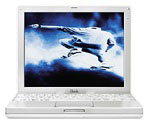The original clamshell
iBook was rugged, had
a useful handle, and had great battery life. It was also heavy,
bulky, and had a relatively low resolution 800 x 600 display. The
"Dual USB" iBook was meant to remedy all of its shortcomings.
Where the clamshell model had weighed 6.6 lb. and was 2.1"
thick, the new iBook weighed just 4.9 lb. and was a mere 1.35"
thick. Apple claimed the new iBook was even more rugged than the
old one. Apple eliminated color options; the new iBook only came in
white. And the new model had a faster system bus, 100 MHz vs. 66
MHz on the clamshell iBooks.
Perhaps the most useful new feature was the 12" 1024 x 768
display, especially as Mac OS X began to displace the Classic
Mac OS as the dominant Mac operating system. That extra screen
space makes a huge difference. And the second USB port wasn't a bad
idea, either.
All dual USB iBooks support the Classic Mac OS as well as
OS X. They officially support adding 512 MB of RAM to whatever
is soldered on the logic board (128 MB in most cases). No G3 iBook
ever shipped with a SuperDrive.
iBook G3/500
Introduced in May 2001 at US$1,299 and up, the dual USB iBooks
use a tray-loading optical drive, and the
original 500 MHz iBook was available with CD-ROM, DVD-ROM,
CD-RW, or a CD-RW/DVD Combo drive. A 10 GB hard drive was standard,
and a 20 GB drive was an option.
The "iceBook" uses an ATI Rage Mobility 128 with 2x AGP with
8 MB of video RAM. It supports VGA output with an included
adapter and has two speakers for stereo sound. It was also the
first iBook with a built-in microphone.
Base memory is 64 MB soldered to the logic board. Apple
increased base RAM to 128 MB on the CD-ROM model and switched to a
15 GB hard drive in October 2001.
iBook G3/600
Apple speed bumped the iBook in October 2001, introducing a
600 MHz model while leaving a 500 MHz
CD-ROM model in the line as an entry-level option. The October 2001
models all came with 128 MB of onboard memory and included 15 GB or
20 GB hard drives. Other than that, they were almost identical to
the early 500 MHz model.
iBook G3/700
The next improvement took place in May 2002, a year after the
first white iBook had been introduced. The
new iBook G3 had a more efficient G3 CPU with twice as large a
cache. It was the first iBook with ATI Mobility Radeon graphics,
and it has 16 MB of video memory (twice as much as earlier
iBooks).
The US$1,199 CD-ROM model ran at 600 MHz and had a 20 GB hard
drive. The US$1,499 Combo drive model ran at 700 MHz and included a
30 GB hard drive.
iBook G3/800
In October 2002, Apple speed bumped the
iBook to 800 MHz and again moved to an improved graphics
processor. The ATI Mobility Radeon 7500 supported up to 32 MB of
video memory.
As before, the CD-ROM model was slower, running at 700 MHz, and
it included 16 MB of video memory. The 800 MHz model had a Combo
drive and 32 MB of video memory.
iBook G3/900
The ultimate 12" G3 iBook was
released in April 2003 and ran as fast as 900 MHz. 32 MB of video
memory was standard on both the CD-ROM and Combo drive models. Hard
drives were bigger, and 128 MB was still the default RAM
configuration.
The 800 MHz CD-ROM model retailed at US$999, and the 900 MHz
Combo drive model sold for just US$300 more.
The G3 iBooks were replaced by G4 iBooks in October 2003.



